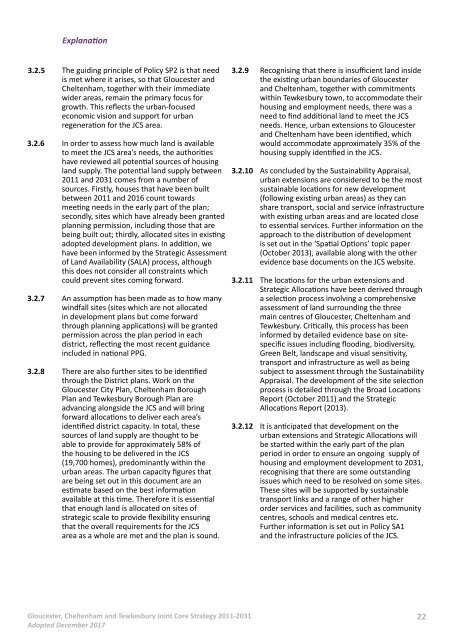JCS_MasterDocument_FIN_27.03.18
You also want an ePaper? Increase the reach of your titles
YUMPU automatically turns print PDFs into web optimized ePapers that Google loves.
Explanation<br />
3.2.5<br />
3.2.6<br />
3.2.7<br />
3.2.8<br />
The guiding principle of Policy SP2 is that need<br />
is met where it arises, so that Gloucester and<br />
Cheltenham, together with their immediate<br />
wider areas, remain the primary focus for<br />
growth. This reflects the urban-focused<br />
economic vision and support for urban<br />
regeneration for the <strong>JCS</strong> area.<br />
In order to assess how much land is available<br />
to meet the <strong>JCS</strong> area’s needs, the authorities<br />
have reviewed all potential sources of housing<br />
land supply. The potential land supply between<br />
2011 and 2031 comes from a number of<br />
sources. Firstly, houses that have been built<br />
between 2011 and 2016 count towards<br />
meeting needs in the early part of the plan;<br />
secondly, sites which have already been granted<br />
planning permission, including those that are<br />
being built out; thirdly, allocated sites in existing<br />
adopted development plans. In addition, we<br />
have been informed by the Strategic Assessment<br />
of Land Availability (SALA) process, although<br />
this does not consider all constraints which<br />
could prevent sites coming forward.<br />
An assumption has been made as to how many<br />
windfall sites (sites which are not allocated<br />
in development plans but come forward<br />
through planning applications) will be granted<br />
permission across the plan period in each<br />
district, reflecting the most recent guidance<br />
included in national PPG.<br />
There are also further sites to be identified<br />
through the District plans. Work on the<br />
Gloucester City Plan, Cheltenham Borough<br />
Plan and Tewkesbury Borough Plan are<br />
advancing alongside the <strong>JCS</strong> and will bring<br />
forward allocations to deliver each area’s<br />
identified district capacity. In total, these<br />
sources of land supply are thought to be<br />
able to provide for approximately 58% of<br />
the housing to be delivered in the <strong>JCS</strong><br />
(19,700 homes), predominantly within the<br />
urban areas. The urban capacity figures that<br />
are being set out in this document are an<br />
estimate based on the best information<br />
available at this time. Therefore it is essential<br />
that enough land is allocated on sites of<br />
strategic scale to provide flexibility ensuring<br />
that the overall requirements for the <strong>JCS</strong><br />
area as a whole are met and the plan is sound.<br />
3.2.9<br />
3.2.10<br />
3.2.11<br />
3.2.12<br />
Recognising that there is insufficient land inside<br />
the existing urban boundaries of Gloucester<br />
and Cheltenham, together with commitments<br />
within Tewkesbury town, to accommodate their<br />
housing and employment needs, there was a<br />
need to find additional land to meet the <strong>JCS</strong><br />
needs. Hence, urban extensions to Gloucester<br />
and Cheltenham have been identified, which<br />
would accommodate approximately 35% of the<br />
housing supply identified in the <strong>JCS</strong>.<br />
As concluded by the Sustainability Appraisal,<br />
urban extensions are considered to be the most<br />
sustainable locations for new development<br />
(following existing urban areas) as they can<br />
share transport, social and service infrastructure<br />
with existing urban areas and are located close<br />
to essential services. Further information on the<br />
approach to the distribution of development<br />
is set out in the ‘Spatial Options’ topic paper<br />
(October 2013), available along with the other<br />
evidence base documents on the <strong>JCS</strong> website.<br />
The locations for the urban extensions and<br />
Strategic Allocations have been derived through<br />
a selection process involving a comprehensive<br />
assessment of land surrounding the three<br />
main centres of Gloucester, Cheltenham and<br />
Tewkesbury. Critically, this process has been<br />
informed by detailed evidence base on sitespecific<br />
issues including flooding, biodiversity,<br />
Green Belt, landscape and visual sensitivity,<br />
transport and infrastructure as well as being<br />
subject to assessment through the Sustainability<br />
Appraisal. The development of the site selection<br />
process is detailed through the Broad Locations<br />
Report (October 2011) and the Strategic<br />
Allocations Report (2013).<br />
It is anticipated that development on the<br />
urban extensions and Strategic Allocations will<br />
be started within the early part of the plan<br />
period in order to ensure an ongoing supply of<br />
housing and employment development to 2031,<br />
recognising that there are some outstanding<br />
issues which need to be resolved on some sites.<br />
These sites will be supported by sustainable<br />
transport links and a range of other higher<br />
order services and facilities, such as community<br />
centres, schools and medical centres etc.<br />
Further information is set out in Policy SA1<br />
and the infrastructure policies of the <strong>JCS</strong>.<br />
Gloucester, Cheltenham and Tewkesbury Joint Core Strategy 2011-2031<br />
Adopted December 2017<br />
22




